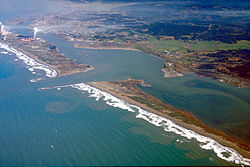Early history
The indigenous Wiyot lived in Tolowot village on Duluwat Island long enough to alter the topography by the accumulation of shell fragments in middens, and the island became tall enough to be visible on the horizon from several miles away. [2]
A non-degree student and employee of the University of California, Llewellyn Lemont Loud (1879–1946), [5] conducted archaeological excavations of the island in 1918 that showed evidence of habitation since around 900 CE. The group of artifacts he excavated and described became known as the Gunther Pattern or Gunther Phase [4] which encompasses the final phase of native dominance lasting until historic times and describes a style of Native American projectile points, grave goods and other archaeological remains which identify a second migration within California around 300 CE. [6] The first major evidence of this came from Gunther Island Site 67 on Indian Island. [4]
Modern era
In 1971 Caltrans built a series of bridges (known collectively as the Samoa Bridge), which cross Humboldt Bay and now directly connect the city of Eureka with the peninsula. Two of these bridges have footings on Tuluwat Island.
Every year since 1992, the Wiyot people and supporters come to the island on the last Saturday in February to heal the community, and remember the human lives lost at the time of the Massacre. Every year participation has increased at the vigil on a nearby island.
In 1998, the Wiyot people began fundraising to repurchase the island in order to be able to again dance the World Renewal ceremony on the island. The first purchase of 1.5 acres (6,100 m2) was made in 2000. [10] In June 2004, the city of Eureka repatriated a further 67 acres (270,000 m2) to the Wiyot Tribe. [9]
The city of Eureka and the Wiyot Tribe installed a temporary erosion control system to mitigate erosion on the site. [11] Clean-up of contamination from the shipyard activities on the first site was certified complete in 2014. [10]
On December 5, 2018, the Eureka City Council voted unanimously to return its remaining land on the island to the Wiyot people, deeding it to the Wiyot Tribe on October 21, 2019. Since that transfer, the Wiyot have owned all of the island except for a few privately owned parcels. [12] [10] Tuluwat Island's repatriation is believed to be the first time a U.S. municipality has returned land to an Indigenous community without strings attached. [13]



